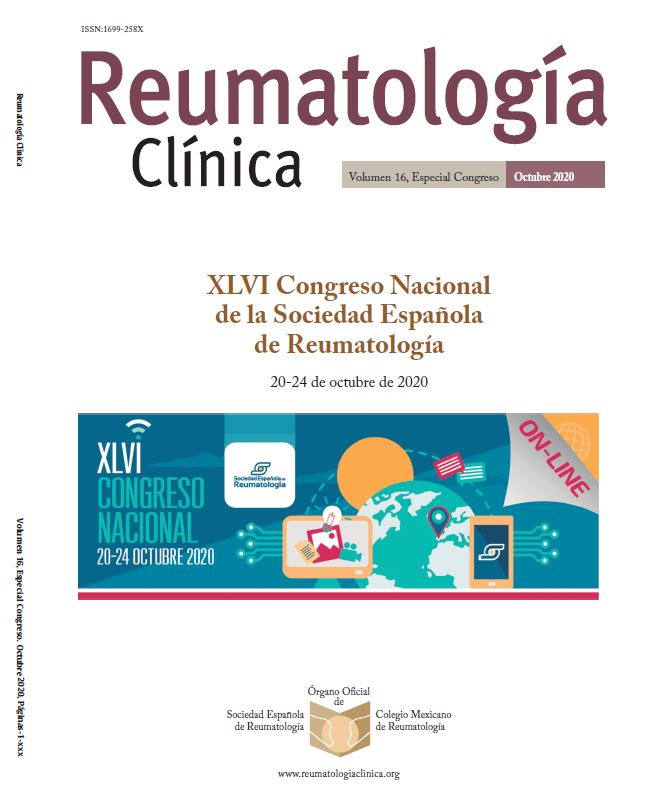CO26 - Choroidal Thickness Measures and Predicts the Response to Biological Therapy in Patients with Ankylosing Spondylitis
1Sección de Reumatología. Hospital Universitario Infanta Sofía. Madrid. 2Sección de Oftalmología. Hospital Universitario Infanta Sofía. Madrid. 3Facultad de Ciencias Biomédicas y Salud. Universidad Europea. Madrid. 4Escuela de doctorado e Investigación. Universidad Europea. Madrid. 5Servicio de Reumatología. Hospital Universitario 12 de Octubre. Madrid. 6Servicio de Oftalmología. Hospital Universitario 12 de Octubre. Madrid. 7Servicio de Reumatología. Hospital Virgen de la Salud. Toledo. 8Servicio de Oftalmología. Hospital Virgen de la Salud. Toledo. 9Servicio de Reumatología. Hospital Universitario de Majadahonda. 10Servicio de Oftalmología. Hospital Universitario de Majadahonda. 11Sección de Reumatología. Hospital Universitario de Móstoles. 12Sección de Oftalmología. Hospital Universitario de Móstoles. 13Servicio de Reumatología. Hospital Universitario Son Espases. Palma de Mallorca. 14Servicio de Oftalmología. Hospital Universitario Son Espases. Palma de Mallorca. 15Servicio de Reumatología. Hospital Clínico San Carlos. Madrid. 16Servicio de Oftalmología. Hospital Clínico San Carlos. Madrid. 17Sección de Reumatología. Hospital Universitario Infanta Leonor. Madrid. 18 Sección de Reumatología. Hospital Universitario Fundación Alcorcón. Madrid. 19Servicio de Oftalmología. Hospital Universitario Fundación Alcorcón. Madrid.
Introduction: and objectives: Choroidal thickness (CT) has been proposed and evaluated as a potential marker of systemic inflammation associated with inflammatory diseases as ankylosing spondylitis (AS). Patients with active AS have a thicker choroid than healthy subjects, regardless of eye inflammation. The evolution of choroid after treatment is poorly known. This study evaluates the CT of patients with severe AS disease activity before and after six months of biological therapy.
Methods: This prospective multicenter study evaluates the CT in 44 patients with high AS disease activity, naïve for biological treatment, and no history of eye inflammation before and after six months of biological therapy, aged from 18 to 65 years. The correlations between the CT and C-reactive protein (CRP) with the disease activity indices and scales as Bath Ankylosing Spondylitis Disease Activity Index (BASDAI), night pain and Patient Global Assessment (PGA) were calculated at baseline and after six months of biological therapy. The concordance between the CT and CRP was determined. Finally, we assessed potential predictors of response to treatment. Clinically important improvement was defined as a decrease in ASDAS score ≥ 1.1 points.
Results: Globally, 44 eyes of 44 patients aged between 18-65 years were included in the study, 12 (27%) women. The biological treatments prescribed were: adalimumab 13 (29.5%), certolizumab 9 (20.5%), secukinumab 10 (20%), etanercept 8 (18%), infliximab 3 (6.8%), and golimumab 1 (2.2%). Mean CT values were significantly higher at baseline than after six months of treatment (baseline 355.28 ± 80.46 μm; 6 months, 341.26 ± 81.06 μm) (p < 0.001). CT decreased both in patients on biological treatment without effect in eye (secukinumab and etanercept; p = 0.024) and in patients on treatment with effect in eye (other; p = 0.005). Also, CRP, BASDAI, night pain and PGA decreased after six months of treatment (p < 0.001, p < 0.001, p < 0.001, p < 0.001). We found a 95% concordance between CT and CRP at baseline and 6 months. Multivariable analysis showed that clinically important improvement was associated with higher CT and age as independent factors (OR 0.97, 95%CI 0.91-0.93; p = 0.009, and OR 0.81. 95%CI 0,7-0.95; p = 0.005). Clinically important improvement was associated with basal CT > 374 μm (sensitivity 78%, [95%CI 60-90], specificity 78% [95%CI 52-92], area under the curve of ROC, 0.70, likelihood ratio 3.6).
Conclusions: CT decreased significantly after six months of biological treatment. CT and CPR had a 95% concordance. A high CT is associated with risk of failure to biological treatment. CT can be considered as a useful biomarker of inflammation and predictor of response to treatment in AS.







